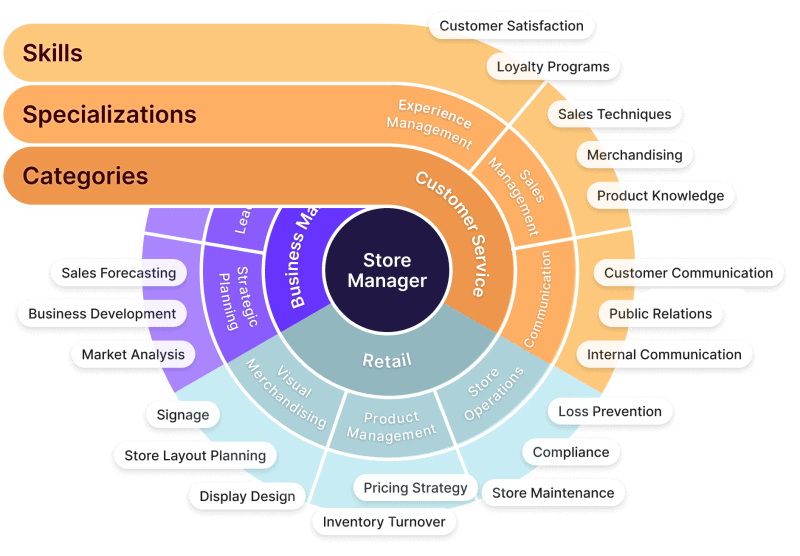Competency mapping is a powerful tool for modern organizations to effectively manage their human resources and optimize performance. In the last few years companies have spent more and more time not only thinking about their competencies but also mapping them to quickly start using skills inside the business. In our experience there are not good reasons not to map your workforce competencies, not even when your team is small (20 people or more). The common belief is that mapping competencies is hard, expensive and not very precise: at Anthropos we are building a solution that is exactly the opposite of that. In today’s article, we will delve into the concept of competency mapping, explore its benefits, understand the process, and provide real-world examples to help you master this essential HR practice.
What is competency mapping and why it is important for modern organizations
Competency mapping is a systematic approach to identify, define, and measure the skills, knowledge, and behaviors required to successfully perform a specific job or role within an organization. It involves creating a competency framework that outlines the key competencies needed for each position, as well as mapping the existing competencies of employees against this framework. We have worked with companies that decided to start with their framework (think of a general document that defines your key skills for specific job positions, roles or departments), writing down skills and competence levels for each one and we also worked with companies that simply wanted to start using skills at scale and they mapped all their skills to start looking at them and later on consider a framework.
Competency mapping is crucial for modern organizations as it helps align individual capabilities with organizational goals, ensuring a clear and consistent understanding of performance expectations. By identifying competency gaps and areas for development, organizations can, for example, make informed decisions about hiring, training, and performance management. In today’s rapidly changing business landscape, every business is constantly striving to stay ahead of the competition. This requires not only having a talented workforce, but also ensuring that employees possess the right skills and abilities to meet the evolving demands of their roles. Competency mapping plays a vital role in achieving this objective.
It’s by conducting a thorough competency mapping exercise that organizations can in fact gain a comprehensive understanding of the skills and knowledge required for each job position. This enables them to establish clear job descriptions and performance expectations, which in turn helps attract and retain top talent. When employees have a clear understanding of the competencies they need to excel in their roles then, they are more likely to be engaged and motivated. Several companies use competencies to build specific career paths for their people but also to facilitate internal mobility and take advantage of specific skills inside the organization without the need to hire new employees.
What are the benefits of mapping competencies and how your HR team can take advantage of it
As we’ve seen, the benefits of competency mapping are numerous, ranging from improved recruitment and selection processes to enhanced employee development and performance management.
By mapping competencies of your workforce, your HR team can i.e.:
- Identify and attract the right talent: Competency mapping enables your HR team to clearly define the required skills and qualities for each position, ensuring that job descriptions and job advertisements accurately reflect the desired competencies.
- Enhance employee performance: By mapping competencies, your HR team can identify performance gaps and provide targeted training and development opportunities to bridge those gaps. This ensures that employees have the necessary skills and knowledge to excel in their roles.
- Facilitate succession planning: Competency mapping enables your HR team to identify high-potential employees and develop succession plans for key positions. This ensures a smooth transition when employees leave or retire, minimizing the impact on organizational performance.
- Improve job satisfaction and employee engagement: When employees clearly understand the competencies required for their roles and have opportunities for growth and development, job satisfaction and engagement levels increase while turnover usually decreases. This, in turn, leads to higher productivity and performance.
Competency mapping process
A competency mapping process is a crucial part of talent management strategy and organizational development. It involves a systematic approach to identifying and developing the key competencies required for successful performance in various job roles within an organization.
By aligning competencies with organizational goals and values, companies can ensure that their employees possess the necessary skills and knowledge to contribute effectively to the overall success of the business.
But what are the steps typically involved in a competency mapping process and how you can start your own within your company?
Identify job roles
Start by identifying the key job roles within your organization. This could be done through job analysis and consultation with department heads and subject matter experts or it can be automated with a solution like Anthropos (we map automatically all the job roles inside an organization). By understanding the specific requirements and responsibilities of each role, you can determine the competencies needed for success.
Define competencies
For each job role, define the competencies required for successful performance. These competencies should align with the organization’s goals and values. This step involves identifying the knowledge, skills, abilities, and behaviors that are essential for employees to excel in their respective roles.
Evaluate existing competencies
Assess the competencies of your current employees against the defined competency framework. This can be done through interviews, self-assessments, and performance evaluations. By evaluating the existing competencies, you can identify the strengths and weaknesses of your workforce and determine the areas that require further development.
Identify competency gaps
Identify the gaps between the desired competencies and the existing competencies of employees. This will help you determine the areas that require development and training. By identifying these gaps, you can create targeted development plans to bridge the skills and knowledge deficiencies.
Develop a training and development plan
Create a tailored plan to address the identified competency gaps. This may involve providing training programs, mentoring, coaching, or on-the-job learning opportunities. By investing in the development of your employees, you can enhance their performance and ensure that they have the necessary competencies to meet the evolving needs of the organization.
Monitor and evaluate progress
Continuously monitor and assess the progress of employees in developing the required competencies. Regular feedback and performance evaluations can help track improvement and identify further development needs. By providing ongoing support and guidance, you can empower your employees to reach their full potential and contribute to the overall success of the organization.
Competency mapping examples
To better understand competency mapping, let’s explore a couple of examples of its benefits applied to different job roles:
Example 1: Sales Manager Competency Mapping
A sales manager is a key role in any business. The competencies required for this role may include leadership, strategic thinking, communication, sales planning, customer relationship management, and results orientation. By mapping the competencies of existing sales managers against these desired competencies, organizations can identify areas for improvement or potential successors for future growth. A typical topic for this role is product knowledge: every sales manager needs to know the product they sell particularly well and in some cases, that requires technical or domain-specific knowledge. Mapping the skills of your sales managers helps the company understand how quickly they can bring to market new products but also how they can assign specific sales managers to particular products or regions based on their product knowledge understanding.
Adopting Anthropos, the company can map the skills of every single employee inside the organization and centralize all of them to quickly find employees for specific skills, projects or needs. Not only that, it’s easy to use our career paths to automatically assign specific training to a group of people based on their skills or lack of. In this case it would be easy to automatically train all the sales managers to be at a specific product knowledge. The career path – like the skills – can be fully customized inside Anthropos and you can even decide to create a Job Simulation to let your sales manager test their product knowledge skills in a safe environment as if they were in front of real customers.
Example 2: Software Engineer Competency Mapping
Software engineers are among the most competitive roles you can try to hire and retain in your company (more about software engineers retention in our recent guide). Mapping their skills is usually a great strategy to help their retention creating a clear career path but also a critical step to make sure your business has an idea of the skills and technologies you have access to inside your team: a great example is how AI is changing the way companies build their services and software. Several companies are now relying on their internal software engineers to introduce AI in their products: having a clear mapping of their skills helps them identify those engineers that have already built software using AI solutions like OpenAI or even better the ones that aspire to do more with AI and have been playing in their spare time with these tools.
Of course the same is valid for every single technology or framework you decide to focus on inside your organization. Anthropos can spot real-time the knowledge and skills of your software engineers and show you the best fit for any project.

An example of what Anthropos shows in real time inside your company. All the skills mapped inside a team and the ability to find the employees that have them.
Conclusions
By understanding what competency mapping is and following a systematic process to implement it, you can unleash its full potential for your team.
In designing Anthropos we focused on a solution that allows you to take advantage of all the benefits of competency mapping through a comprehensive set of features that starts from an effective and modern approach to leveraging people’s skills in your organization.
Our platform has built-in features that let you map the competencies of your workforce, track your company’s evolution, optimize internal resources and develop your team’s skills in advance to fill knowledge gaps and leverage opportunities you otherwise wouldn’t probably see.
See Anthropos in action, book a demo with a strategy consultant.
Stefano
January 10, 2024


